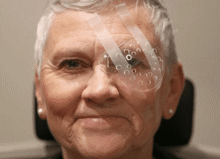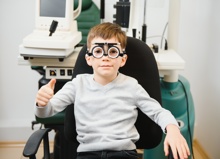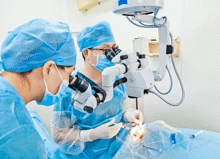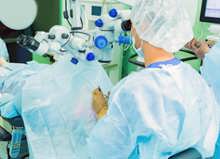A cataract is an eye condition that causes blurry vision and in severe cases vision loss and blindness. They are extremely widespread with as many as 400,000 people undergoing cataract surgery every year in England (NHS, 2022).
Age is the main factor contributing to people developing cataracts with those over 60 at a much greater risk of developing the condition. As we get older, looking after our eyesight becomes vital to protecting our well-being. Improving eye health and attending regular eye exams can help reduce your chances of developing the condition.
What are cataracts?
Cataracts occur when the eye’s lenses become clouded or misted over. This happens naturally as a part of ageing when proteins in the lens begin to break down. Cataracts may start off symptomless, then cause patches of blurry vision and eventually lead to severe vision loss and blindness.
The lens is an important part of the eye’s anatomy that refracts light towards the retina. In young people, the lens is completely transparent but over time it tends to become cloudy. This affects the way light hits the retina and leads to vision loss associated with cataracts.

Some cataracts are not caused by ageing and may be related to an eye injury, surgery complications, or a different eye condition.
The different types of cataracts
Cataracts are categorised differently depending on how they affect the lens, at what stage of life they develop and their causes.
Age-related cataracts: Most cataracts are caused by the natural processes of ageing, which affect the anatomy of the eye. However, the risk of developing age-related cataracts also depends on other factors like whether you have a genetic history of the condition and if you had undergone eye surgery.
Congenital cataracts: This type of cataract is present at birth. In many cases, treatment will be required to limit long-term effects on vision. There are other kinds of cataracts that develop later on in childhood, which may also have genetic causes.
Secondary Cataracts: One of the main downsides to cataract surgery is that the condition may come back. This is referred to as secondary cataracts and may happen shortly after surgery or years later.
Traumatic Cataracts: When the eye’s lens is damaged due to an injury it may become cloudy. This can happen shortly after an injury or develop later in life.
If you are diagnosed with cataracts, your optometrist may also explain that you have nuclear sclerotic, cortical and posterior subcapsular cataracts. This refers to whether the centre, front or back of the lens is affected. These different types may affect the severity of the condition and how it develops.

Symptoms and Signs
Cataracts have a variety of symptoms and not everyone experiences the same ones. They will affect your vision gradually, so you may not notice any symptoms at first.
Here are some of the most common symptoms:
- Cloudy, hazy or blurry vision
- A change in the way you perceive colours (colours may appear faded or everything may have a yellow or brown shade)
- Light sensitivity
- Seeing halos or glare
- Difficulty seeing at night
These are sometimes referred to as the five symptoms of cataracts. However, you may also experience shortsightedness, especially if you are older, and the frequent need to change your glasses or contact lenses.
Causes and Risk Factors
Cataracts have a variety of causes and some people are at greater risk than others. While factors like age and genetics may make cataracts impossible to avoid, learning about other causes can help you to minimise your chances of developing them.
- Ageing: As we get older, the anatomy of our eyes changes including proteins in the lens breaking down and causing cloudy vision. While this cannot always be prevented improving general eye health can help keep your vision better for longer.
- Genetic history: Genetic factors may mean you are born with cataracts (congenital cataracts) or it may mean you are more likely to get them later in life.
- Diabetes: High blood sugar levels can cause changes in the eyes’ lenses which may lead to cataracts.
- Injury: Injuries to the eye can lead to traumatic cataracts. This is why it’s important to wear protective eyewear when carrying out activities that may affect your eyes.
- Radiation: if you are regularly exposed to UV light you may get cataracts through radiation.
- Smoking and excessive drinking: Both drinking excessively and smoking have been strongly linked to the likelihood of developing cataracts.
- Diet: what we eat affects our eye health and diets lacking in vitamins and nutrients can increase the risk of conditions like cataracts.
Diagnosis and Treatment Options
Cataracts are diagnosed during a comprehensive eye exam using a series of tests. Your optometrist will review your case history and ask you about any symptoms you are experiencing. Then, they will examine your eyes using a slit-lamp examination, a visual acuity test and a retinal exam.
Slit-lamp examinations allow optometrists to look at the different structures within the eye, including its lens. A slit-lamp is a kind of microscope that uses a narrow beam of light to look into the eye, allowing the optometrist to detect any abnormalities.
A visual acuity test is a way of assessing how well you can see at different distances using an eye chart. This can help the optometrist determine whether you are experiencing vision loss and to what extent it has progressed.
Retinal exams involve having your pupils dilated so the optometrist can look at the back of the eye. This enables them to look for signs of cataracts and other eye conditions that may be visible in the retina.
Eye exams can detect cataracts before you notice any symptoms yourself. This is why it is important to stay up-to-date with eye exams, especially if you have a higher risk of developing the condition.
The only treatment option for cataracts is surgery, though contact lenses and glasses can be prescribed to manage the symptoms. This can be highly effective with mild cataracts. However, if your cataracts begin to interfere with daily practical tasks it may be time to consider surgery.

Cataract Surgery
Cataract surgery involves removing the clouded lens within the eye and replacing it with an artificial one. It is a highly effective surgery with a good success rate. However, there are possible side effects and complications – you should discuss the decision to have surgery in detail with your optometrist.
The surgery is carried out with local anaesthesia and usually takes between 30 and 45 minutes (NHS, 2017). It involves making a small incision in the eye and removing the cloudy lens. An Intraocular Lens (IOL) is then inserted which should provide you with accurate, unclouded vision. It may take several weeks to fully recover from the surgery.
Cataract surgery is considered to be generally safe, but there are risks of complications including bleeding, infection and damage to other parts of the eye.
It can be challenging to decide whether surgery is the right option for you, as lifestyle changes and managing symptoms with glasses or contact lenses may be a feasible choice. Discussing your options with an optomoetrist is the best way to get accurate information to help you make your decision.
Prevention and Lifestyle Changes
Preventing cataracts is not always possible and many of us will experience it as a part of ageing. Nevertheless, making changes to improve eye health can help limit the risks of developing the condition and minimise its effects.
Quitting smoking is an excellent way to limit your risk of developing eye conditions. Alongside excessive drinking, it has been strongly linked to cataracts.
Improving diet and getting regular exercise can also make a big difference. Ensuring you eat plenty of fruits and vegetables as well as nuts, seeds and other foods rich in omega-3 fatty acids, can help improve eye health.
High blood sugar levels can lead to changes in the structure of the eye’s lens. So, for people with diabetes, controlling blood sugar levels is vital to protecting their eye health.
Wearing UV-protected eyewear and avoiding overexposure to sunlight is a good way to limit the development of cataracts due to radiation.
Following these guidelines as best as possible can help to improve your eye health and reduce your risk of developing cataracts.
Coping with Cataracts and Seeking Help
Learning you have cataracts can be a difficult experience. People all over the world have this eye condition, and there are a wide variety of networks and support services to help you manage it.
Your optometrist can not only provide the best information and clinical care but can recommend vision rehabilitation services and other ways to cope with your condition.
Conclusion
Cataracts are a condition that many of us will have to deal with in the course of our life. Looking after your eyes with regular visits to an optometrist and a proactive consideration of eye health can limit your risk of developing cataracts and improve your quality of life.
While it can be easy to forget about your eye health, prioritising it can make a huge difference in the long term. Remember that healthcare professionals can provide the best advice and information if you have concerns or questions about your eye health.
References
NHS (2017). Cataract surgery. Available at: https://www.nhs.uk/conditions/cataract-surgery/.
NHS (2022). Making a decision about cataracts. Available at https://www.england.nhs.uk/wp-content/uploads/2022/07/Making-a-decision-about-cataracts.pdf.







